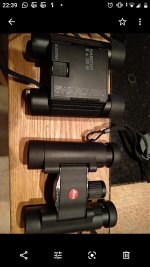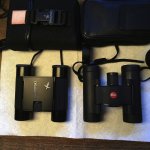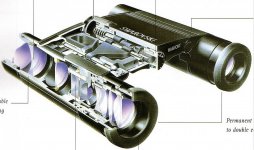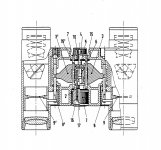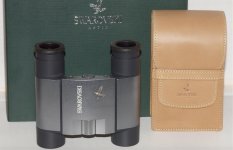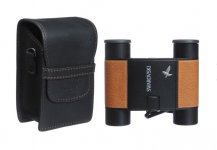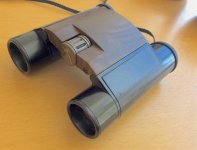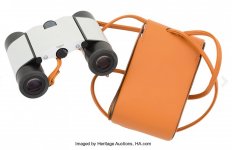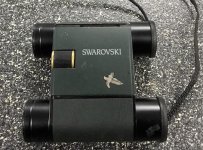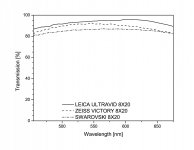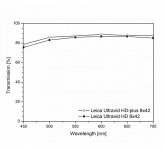I like the 8x20 format and have been through a few models. I have a question for others who may have greater knowledge than I. First, a few caveats: I realise there is sample variation. Also, one can´t really compare "from memory". And no two sets of eyes are the same. And no two eyeballs, even in the same head, are equal. And one man´s pocket is another man´s bag (i.e. 8x20 is too small for some people, and 8x25 has gained popularity...but it´s too big for my needs). Anyway, here´s my observation/question. I had a "new" Swarovski 8x20B, made in 2016 (I think). I bought a used Leica Ultravid 8x20 from a goodly BF member a few years ago. Comparing them, I found each to have specific advantages (Swaro smaller, lighter, wider FOV), but preferred the contrast and "punch" and colour rendition of the Leica, also finding it a hair "sharper". (I realise these are not technical terms but there you go). Recently, I sold the Swaros. Then I thought, erroneously, that I had lost the Leicas, and bought a secondhand pair of Swaro 8x20B on ebay, from Germany. They turned out to be the "old" version, made in 1992 (using the "first two digits plus 30" formula, anyway). I was impressed. Then I found my Leicas under a pile of books or something. And, in true obsessive fashion, took the Ultravids and the "old version" Swaros out to compare them. Oddly, I found the 1992 Swaros, to my eyes, to be a hair´s breadth sharper than the Leicas, and to perform really well in odd lighting, with no glare or wash-out or whatever you call it. So, even though I no longer have the 2016 version Swaros to compare, I think that, to my eyes, the "old" Swaros were superior. Again, this may be simple sample variation. In any case, not trusting my eyes, or judgement, I called on Mme. Sanch for her opinion. She has no interest in binoculars, carries no optics-baggage psychologically (or physically), simply looks, observes, and delivers a "I-prefer-this-one" judgement. Lo and behold, in various lightings and at various distances, she also prefers the "old" Swaro 8x20B, from 1992, over the Leica Ultravid 8x20. Being a sensible person, she says the difference is tiny, hardly noticeable to a sensible person, what does it matter, both are brilliant, etc. etc. etc. But I wonder. Is there something "different" about the old 1992 Swaros? I imagine they don´t have Swarotop/Swarodur etc., but I wonder if, for example, they have lead glass or something else that makes them different? I´d really appreciate observations from anyone who knows. And I realise the final caveat, that none of this really matters. BTW, in the photo you can see the "old" Swaros had "AUSTRIA" and "HABICHT 8x20" printed on the central body plate, and no little hawk symbol. Kind of cute, in a retro ´90s way. Simple rubber eyecups too, non-adjustable other than folding them down if you wear glasses.
Attachments
Last edited:





